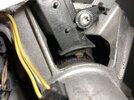These are compatible brushes for my machine they’re a match to ones I took off.I'm only judging from a blurry photo, but the carbon of the brush tip, appears not to be a good match to the comm..
The entire face of a carbon brush, should be in full contact with the comm..
Blurry photo??? That photo is crystal clear and well lit, I even used a secondary light source than just the flash! it’s a gorgeous picture.
Attachments
Last edited:



